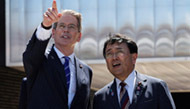▶ A plan for safer growth, away from Port-au-Prince.
growth, away from
Port-au-Prince.
Even as outsiders feel sympathy for Haiti’s suffering, they tend to look upon it as a country beyond saving.
Now there is a plan to do just that, and it is surprisingly convincing. The lucid, far-reaching reconstruction guidelines that the Haitian government unveiled at a donors’ conference at the United Nations should give all who care about Haiti’s future cause for hope.
Prepared by a group of urban planners from the Haitian government agency responsible for the country’s development, the plan is built around a bold central idea: to redistribute large parts of the population of Portau- Prince to smaller Haitian cities, many of them at a safe distance from areas most vulnerable to natural disaster. In the process the plan would completely transform Haiti from a country dominated by a single metropolis to what the planners call a network of smaller urban “growth poles.”
The guidelines are still in an early stage, and Haiti’s fate will ultimately have a lot to do with economic and political developments beyond the scope of planners. But the guidelines already surpass any of the early reconstruction plans for post-Hurricane Katrina New Orleans or for the parts of Asia affected by the tsunami in 2004. The proposal’s well-reasoned thinking about environmental threats and the history of urban development in Haiti suggests that they could become a reliable blueprint not just for reconstruction, but also for solving many of the urban ills that have plagued the country for decades.
The causes of those troubles can be traced back a century. Haiti was once primarily rural, with its major economic activity distributed among several ports along the northern, western and southern coasts. But after the United States invaded in 1915, the Americans began to concentrate most trade operations in Port-au-Prince, the site of their military headquarters. The port was dredged to make room for big new steamships; other major ports, to the north and west, began to lose their importance. By the middle of the 1960s, Francois Duvalier had shut down the other ports entirely as part of an effort to concentrate his power base in the capital.
The growth of Port-au-Prince accelerated in the political turmoil after Duvalier’s son and heir, Jean-Claude, fled the country in 1986. Over the next 20 years, the city’s population nearly doubled, to close to three million people, according to some estimates.
The effect of this shift was an urban disaster ? one that has put more and more pressure on the capital while draining the provinces of economic opportunity.
“You need to restore a balance,” said Leslie Voltaire, an urban planner and a special envoy to the United Nations . “If we don’t do anything, Port-au- Prince is expected to grow to 6,000,000 in the next 15 years. It will become an incubator for further crime and violence. Our economic advantage is in agriculture and tourism, and these are by nature decentralized.”
The notion of shrinking the capital and reviving provincial cities dates back to 1987. It was enshrined as a goal in the post-Duvalier constitution by a government seeking to redistribute political power and has been brought up periodically by urban planners ever since, to little effect.
The environmental and geological concerns raised by the earthquake have made this approach seem all the more critical.
In essence, the guidelines treat the recent disaster as an opportunity. Thousands of public buildings in Port-au- Prince were destroyed by the earthquake, including schools, hospitals and markets. Around 600,000 survivors have since fled the capital for cities like Cap Haitien, in the north, and Hinche, in the central plateau. The population of Gonaives, a port city on the west coast , has swollen to 300,000 from 200,000 in less than three months.
By relocating many schools and hospitals to smaller cities, planners hope to create an economic incentive to keep people from returning to Portau- Prince once reconstruction begins. The new buildings could be organized around public squares and parks to provide civic centers to communities sorely lacking in them.
Planners have outlined a similar approach for rural villages, with farms encircling a communal core containing a market, a school and healthcare facilities.
“This will only work if these poles become magnets of attraction - with agriculture, tourism, industry and especially jobs,” Mr. Voltaire said. “Otherwise, these people are going to come back.”
NICOLAI OUROUSSOFF / ARCHITECTURE
스마터리빙
more [ 건강]
[ 건강]이제 혈관 건강도 챙기자!
[현대해운]우리 눈에 보이지 않기 때문에 혈관 건강을 챙기는 것은 결코 쉽지 않은데요. 여러분은 혈관 건강을 유지하기 위해 어떤 노력을 하시나요?
 [ 건강]
[ 건강]내 몸이 건강해지는 과일궁합
 [ 라이프]
[ 라이프]벌레야 물럿거라! 천연 해충제 만들기
 [ 건강]
[ 건강]혈압 낮추는데 좋은 식품
[현대해운]혈관 건강은 주로 노화가 진행되면서 지켜야 할 문제라고 인식되어 왔습니다. 최근 생활 패턴과 식생활의 변화로 혈관의 노화 진행이 빨라지고
사람·사람들
more
“취미생활로 다진 친목… 선후배들과 만든 모교사랑”
사진러브한인 사진 동호회 사진러브(회장 크리스 고)는 13일 용수산에서 송년모임을 갖고 한 해를 마무리하는 뜻깊은 시간을 가졌다. 이날 모임에…

[홀인원] 이상원 박사
일반외과 전문의 이상원(왼쪽) 박사가 지난 9일 뉴포트비치 소재 골프장 9번 홀(152야드)에서 레스큐 클럽으로 친 샷이 그대로 홀에 빨려 들…
[송년행사 게시판] 재미시인협회
재미시인협회(회장 지성심)는 오는 20일 오후 4시 가든스윗호텔에서 한 해를 마무리하며 동인지 ‘외지’ 제35집 출판 기념회와 ‘제23회 재미…
[송년행사 게시판] 향군단체 연합
6.25 참전유공자회와 대한민국 육군협회 등 남가주 지역 향군 단체 연합은 19일 오전 11시30분, 용궁에서 송년 행사를 개최한다. 드레스코…
[송년행사 화보] “이웃과 함께 나누고 지인과 함…
KYCC13일 윌튼 플레이스 초등학교에서 열린 ‘한인타운청소년회관(KYCC) 홀리데이 카니발’이 성황리에 막을 내렸다. 올해는 KYCC 창립 …
많이 본 기사
- “1인당 2,000달러 환급금·세금 부담 역대 최저”
- ‘반이민 가속페달’⋯ 시민권자도 대거 추방
- ‘수퍼 독감’ 확산… 확진 4배 급증
- 캐롤라이나 항공기 추락 조종사·일가족 7명 사망
- 트럼프 행정부, 대마초 규제 완화
- 인텔 준국유화·US스틸 황금주… 트럼프, 산업·금융 쥐락펴락
- 한인 부인 살해 혐의 남편 법정 출두 무죄 주장
- 베네수엘라, 해군에 “유조선 호위하라”
- 반세기 붓길을 돌아보다⋯남강 김선희 작가 서예전
- [나르지오 글로벌 ] “발끝에서 전하는 특별한 건강 선물”
- 천정궁엔 언제? 시계는 어디에?…전재수 불렀지만 첩첩산중
- 시신 훔쳐 팔아넘긴 부부 징역 중형
- 한인 다큐 감독 크리스틴 최 별세
- 한인 학생들, 로즈데일 애국지사 묘역 꾸미기 행사
- 존 이 시의원 13만불 벌금 LA윤리위원회 최종 판결
- PSG, 인터콘티넨털컵 우승으로 6관왕 대기록
- [커뮤니티 게시판] 한인직업교육센터, 새학기 수강신청 접수
- 홍명보호, 최소 1,050만 달러… 8강 진출 시 2,050만 달러‘잭팟’
- 주방위대 ‘홀리데이 볼’ 성료
- [전익환 프로의 골프교실] 아이언 샷
- 내년 금리인하 전망… 연준 1회, 시장은 2회
- SK온, 포드와 합작 청산… 미 배터리공장 각자 운영
- [화제] 베조스 전 부인… ‘기부의 여왕’ 변신
- 거주·투자용 한국 부동산 인기… 한인 유치 ‘치열’
- 한인 헤지펀드 거물, CNN 인수 추진
- 오픈AI 가치 7,500억불 대규모 투자 유치 나서
- ‘최강’ 안세영, 셔틀콕 왕중왕전 4강 진출 확정
- 한국타이어, 테네시공장 증설… 생산 두배로
- 가주 실업률 5.6%로 상승… 전국 최고
- 구리 절도 기승⋯ 가로등 ‘깜깜’
- 전현무, 차량 링거 결국 입 열었다.. “의사 진료 처방..불법 NO”
- “연대의 빛으로 증오 극복”
- 팀스피릿 부동산그룹 송년모임
- 전국 소매판매 다시 부진 최근 5개월새 최저 수준
- AI 인프라 구축, 인허가 절차 완화
- 차기 연준의장 곧 발표 트럼프, 3∼4명과 만나
- 신규 실업수당 감소 1주전보다 1만3천건↓
- 오스카 시상식, 2029년부터 유튜브 생중계
- 현대차그룹, 차량 충돌 평가 ‘최고 등급’
- 잇단 총격·테러 음모… 한인타운 안전 우려
- ‘재무장 선언’ 독일, 군장비 대거 구매
- [만화경] 웰다잉 인센티브
- 물가 둔화하나… 11월 소비자물가 2.7% 상승
- 제네시스, 비영리 단체들에 300만달러 지원
- [금요단상] AI와 동거, 그 실체
- [한국춘추] 경제대공황ㆍ제2차 세계대전 승리로 극복한 루스벨트 리더쉽
- 2025년, 성찰과 감사의 마무리를
- “첼시 판 돈 우크라에 쓰라” 영국, 러 재벌에 최후 통첩
- [왈가 왈부] 고환율에 외환 건전성 완화·서학개미 규제… 미봉책 아닌가요
- “취미생활로 다진 친목… 선후배들과 만든 모교사랑”
1/5지식톡

-
 ☝️해외에서도 가능한 한국어 선생님…
0
☝️해외에서도 가능한 한국어 선생님…
0이 영상 하나면 충분합니다!♥️상담신청문의♥️☝️ 문의 폭주로 '선착순 상담'만 진행합니다.☎️ : 02-6213-9094✨카카오톡ID : @GOODEDU77 (@골뱅이 꼭 붙여주셔야합니다…
-
 테슬라 자동차 시트커버 장착
0
테슬라 자동차 시트커버 장착
0테슬라 시트커버, 사놓고 아직 못 씌우셨죠?장착이 생각보다 쉽지 않습니다.20년 경력 전문가에게 맡기세요 — 깔끔하고 딱 맞게 장착해드립니다!장착비용:앞좌석: $40뒷좌석: $60앞·뒷좌석 …
-
 식당용 부탄가스
0
식당용 부탄가스
0식당용 부탄가스 홀세일 합니다 로스앤젤레스 다운타운 픽업 가능 안녕 하세요?강아지 & 고양이 모든 애완동물 / 반려동물 식품 & 모든 애완동물/반려동물 관련 제품들 전문적으로 홀세일/취급하는 회사 입니다 100% …
-
 ACSL 국제 컴퓨터 과학 대회, …
0
ACSL 국제 컴퓨터 과학 대회, …
0웹사이트 : www.eduspot.co.kr 카카오톡 상담하기 : https://pf.kakao.com/_BEQWxb블로그 : https://blog.naver.com/eduspotmain안녕하세요, 에듀스팟입니다…
-
 바디프렌드 안마의자 창고 리퍼브 세…
0
바디프렌드 안마의자 창고 리퍼브 세…
0거의 새제품급 리퍼브 안마의자 대방출 한다고 합니다!8월 23일(토)…24일(일) 단 이틀!특가 판매가Famille: $500 ~ $1,000Falcon: $1,500 ~ $2,500픽업 & 배송직접 픽업 가능LA…
케이타운 1번가
오피니언
 한영일 / 서울경제 논설위원
한영일 / 서울경제 논설위원[만화경] 웰다잉 인센티브
 캐슬린 파커 워싱턴포스트 칼럼니스트
캐슬린 파커 워싱턴포스트 칼럼니스트 [캐슬린 파커 칼럼] 아이들을 온라인에서 보호하기
 양상훈 수필가ㆍ시인
양상훈 수필가ㆍ시인 [한국춘추] 경제대공황ㆍ제2차 세계대전 승리로 극복한 루스벨트 리더쉽

[왈가 왈부] 고환율에 외환 건전성 완화·서학개미 규제… 미봉책 아닌가요
 수잔 최 한미가정상담소 이사장 가정법 전문 변호사
수잔 최 한미가정상담소 이사장 가정법 전문 변호사 [수잔 최 변호사의 LIFE &] AI 시대 편리함에 안주하지 말자
 김도년 성균관대 건축학과 교수 스마트도시·건축학회장
김도년 성균관대 건축학과 교수 스마트도시·건축학회장 [로터리] 지멘스가 만드는 미래 동네
1/3지사별 뉴스

‘브라운대 총기참사’ 뉴욕 한인학생도 총상
▶총상 입은 상황서도 동료학생 의식 잃지않도록 도와 ▶부친도 동문 “우리 가족에게 고통스러운 일”지난 13일 발생한 브라운대학교 총기난사(본보…
뉴욕주 안락사 합법화 초읽기 호쿨, “안전장치 마련되면 서명”

워싱턴 일원 소비 확 줄어들었다
올해 8월 워싱턴DC에 범죄와의 전쟁을 명분으로 주방위군이 본격적으로 배치된 가운데, 이 시기 이후부터 버지니아와 메릴랜드, DC 등 워싱턴 …
“북VA 주택시장 가격 급등 없다”

베이지역 스포츠팀, SF 한인회에 후원금
샌프란시스코 베이지역 한인회(회장 김한일)는 한인 메이저리거 이정후 선수의 소속팀인 샌프란시스코 자이언츠(San Francisco Giants…
불자커뮤니티 20일 청소년발표회및 송년회

오늘 하루 이 창 열지 않음 닫기 




















































.png)


댓글 안에 당신의 성숙함도 담아 주세요.
'오늘의 한마디'는 기사에 대하여 자신의 생각을 말하고 남의 생각을 들으며 서로 다양한 의견을 나누는 공간입니다. 그러나 간혹 불건전한 내용을 올리시는 분들이 계셔서 건전한 인터넷문화 정착을 위해 아래와 같은 운영원칙을 적용합니다.
자체 모니터링을 통해 아래에 해당하는 내용이 포함된 댓글이 발견되면 예고없이 삭제 조치를 하겠습니다.
불건전한 댓글을 올리거나, 이름에 비속어 및 상대방의 불쾌감을 주는 단어를 사용, 유명인 또는 특정 일반인을 사칭하는 경우 이용에 대한 차단 제재를 받을 수 있습니다. 차단될 경우, 일주일간 댓글을 달수 없게 됩니다.
명예훼손, 개인정보 유출, 욕설 등 법률에 위반되는 댓글은 관계 법령에 의거 민형사상 처벌을 받을 수 있으니 이용에 주의를 부탁드립니다.
Close
x